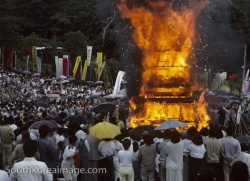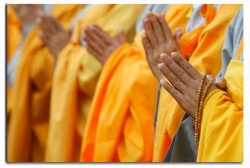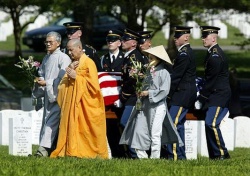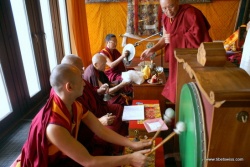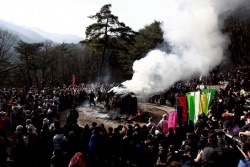Buddhism Funeral Traditions
As it all began, Buddhism was founded in the sixth century B.C., in northern India by Siddharta Gautama, who was the son of a king, in what now, is known as Southern Nepal. This religion through many centuries flowered from Asia and had Asian immigrants go to the U.S., in the early third of the 19th century. This brought Buddhism to America. Buddhism also went to Canada in the middle of the 19th century when the Chinese arrived first from California and then from Hong Kong. The three most major Buddhist centers are Toronto, Vancouver, and Montreal
Funeral and Mourning
According to the Buddhist Belief, each individual passes through many reincarnations until they are liberated from worldly illusions and passions. They have entered nirvana, Sanskrit for "a blowing out as of a flame". One enters a new incarnation immediately after death. There are three components to a Buddhist funeral ceremony and they are sharing, the practice of good conduct, and developing a calm mind, or meditation. A funeral in many Japanese Buddhists traditions consists of a eulogy with prayers at a funeral home, resembling similar ceremonies in the west. These funerals may last up to 1 hr and 15 minutes. In Cambodian, Thai, and Ceylonese ceremonies and funerals they have three, which each one can last up to 45 minutes.
Before Ceremonies
The time the funeral takes place after a death depends on the Buddhist traditions of the bereaved. In certain Japanese traditions, the funeral is usually within one week. Cambodian, Ceylon, and Thailand, there are three ceremonies. The first ceremony is held at the bereaves house by a monk within the first two days of the death. The second ceremony is held within two to five days of the death at the funeral home which a service is conducted by a monk. The third one is held after seven days of the burial or cremation. A monk hold a ceremony at the bereaves house or at a temple. The last ceremony which is called "merit transference", seeks to receive good energy for the deceased in his or her new incarnation. If you are not in the Buddhist religion, it is inappropriate to communicate with the bereaved before the funeral.
Appropriate Attire
Men: Standards for attire vary widely. A majority of the temples expect the men to wear a jacket with a tie. The vast majority allows more casual dress, loose comfortable, casual clothing is especially recommended for those temples in which members and guests sit in meditation cushions on the floor. But it is necessary for the guest call the temple for the seating arrangements and detailing. No head covering is required in the Buddhist temple.
Women: Standards for attire vary widely. A majority of the temples expect the women to wear a dress or a skirt and blouse. The vast majority allows more casual dress, loose comfortable, casual clothing is especially recommended for those temples in which members and guests sit in meditation cushions on the floor. But it is necessary for the guest call the temple for the seating arrangements and detailing. Open-toed and jewelry are permissible. No head covering is required in the Buddhist temple.
In Japanese Buddhist traditions, dark, somber colors for the clothing are advised. In Cambodian, Thai or Ceylonese traditions, white colors are advised.
Gifts
It is appropriate to send flowers to the funeral or make a donation of a range of five to one hundred dollars. That depends on the relation of the deceased. Typically, the bereaved family recommends a specific charity or cause as recipient of donations. It is not appropriate to have foods as gifts.
The Ceremony
In Japanese traditions, the ceremony is usually held in the funeral home. In Cambodian, Thai, and Ceylonese traditions, the first ceremony is held at the bereaves home. The second ceremony is held at the funeral home and the third ceremony is held at the home or at the temple. The right times to arrive at the ceremony would be the time the service is called. You can sit wherever you wish if its at the home. If its a the funeral home there will be pews of sitting. If it is held at the home or temple of the Cambodian, Thai, and Ceylonese traditions, sitting will be probably on the floor on meditation cushions. If you arrive to the temple late you can enter anytime. Most of it the bereaved family will be present before the ceremony. Also the greetings of the family would just to give your condolences. Always there will be a open casket. Also it is appropriate for the guest to view the body because the Buddhism deems the viewing of the body to be a valuable reminder of impermanence of life. When seeing the body there are appropriate behaviors you have to conduct. Bow slightly toward the body as a sign of appreciation of its lesson regarding impermanence. Some of the major officiants at the ceremony would be priest or an minister. These officiants are in the Japanese traditions mostly. The major officiants of the Cambodian, Thai, and Ceylonese traditions is the monk. All the Buddhist traditions use the sect quotes from the Sutras, which are the collections of saying from the Buddha. The order of the ceremony will be announced by the priest or the monk. When the priest and or monk say to stand or give a command and as such the non Buddhist will also do as the Buddhists. The non Buddhists will be included through the whole ceremony. As the ceremony is going on there will be no pictures with or without flash. There will also be no cameras or and tape recorders. Finally the contributions will not be collected
at the ceremony.
The Interment
In the interment or the cremations the guest can come if desired. And if directions are to be asked you would ask the monk or the priest, and the funeral director. After the ceremony and as such the people of the ceremony go to the graveside and prayers are recited and the body is committed to the ground but the guests that are not Buddhists do not participate.
Comforting and Bereaved
As in the comforting it is appropriate to visit the home of the bereaved after the funeral. In the Cambodian, Thai, and Ceylonese traditions, the monks lead a "merit transference" seven days after the burial or cremation. And the purpose of that is to collect good energy for the deceased in his or her new incarnation. In most cases there will be food served at these after death ceremonies. The people that are mourning for the deceased do not have a certain time to go back to work because there are no prescriptions regarding from refraining from work. But it will take up to three months for a mourner to get back to their social schedule. If you are a non Buddhist there are not customs to abide to. After the death, the Japanese, Cambodians, Thai, and Ceylonese have a ninety day memorial. After a year of the death, all four traditions have a "merit transference" ceremony or ceremonies to give good energy to the deceased for their new incarnation. These can be held either at the home of the bereaved or at the temple. There will be food that is served in the integral part of all Buddhist ceremonies.
